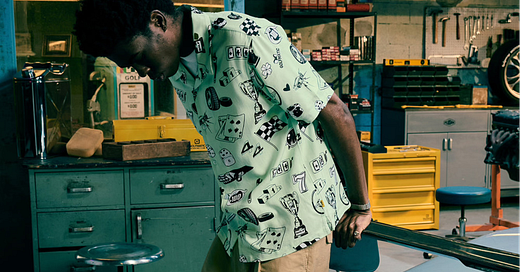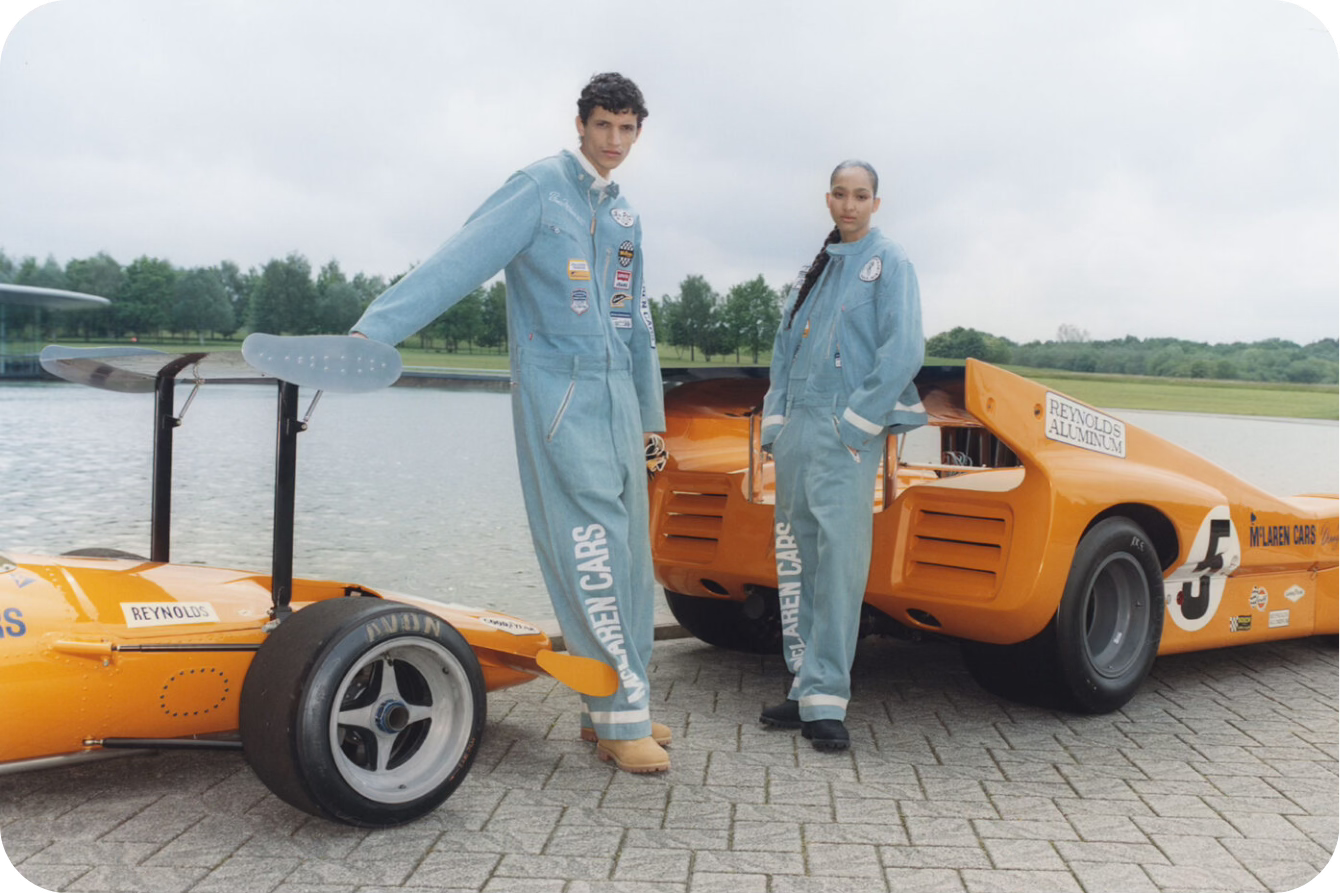The Future of Fashion and F1 Is Bold, Not Predictable
Fashion in Formula One Needs Vision, Not Logos!
Hi there! Welcome to Track Limits, a weekly newsletter where we break down the biggest headlines in F1 and explore the questions, topics, and trends that are shaping the sport. Nothing is off-topic and a little fun is always part of the mix!!
Good evening!! This week, I’m thrilled to introduce the second guest writer for Track Limits’ special feature, Beyond Track Limits — a series where we dive into the topics and trends shaping the sport, with the help of experts and amazing insiders!!
In today’s issue, Alba — a graphic designer and art director — explores the evolving relationship between Formula One and the fashion industry, shedding light on the opportunities and challenges for brands seeking to connect with the sport’s younger, style-savvy fanbase.
Formula 1 has always been a symbol of speed, innovation, and luxury, but surprisingly fashion brands have just started to recognize its potential — and I'm not just talking about designer or prêt-à-porter luxury brands. With the sport's fanbase shifting toward a younger and more female-oriented audience (41% of total F1 fanbase, as determined by Salesforce in 2023), fashion is increasingly looking at Formula One as a valuable space to market its products and reach new consumers.
Since late 2023 and throughout the past season, several fashion and beauty brands have engaged with F1, especially in the United States. However, many of these collaborations failed to live up to their potential, often defaulting to uninspired designs featuring little more than team logos slapped onto basic apparel. An approach mostly used by streetwear brands that felt very "trial mode" to me. Luxury, on the other hand, is scared of the new and didn’t try at all — the fashion industry is very old-fashioned (oops) and afraid of changes (if you think about it, we've been following the same seasonality for YEARS).
But now that luxury is experiencing its biggest decline in years — with almost all iconic brands changing their art directors — I believe we can expect a change in how these companies approach sports, especially Formula One. Lewis Hamilton’s move to Ferrari could and should have the biggest impact particularly on the “Made in Italy” crisis. Now that they have the icon and the visibility, the opportunity for brands like Prada, Miu Miu, Gucci, and Ferrari Style itself, is theirs to take.
The convergence of these two worlds is also driving greater demands from fans and consumers: they want pieces that merge F1's own culture and unique energy with contemporary, fashion-forward designs that either forecast or follow trends.
While last year we saw some standout successes in the F1-fashion crossover, others left much to be desired. A prime example is the Levi's x McLaren collaboration, which could have been a success if it had thought outside the box. Simply putting logos on garments doesn’t classify as fashion — it’s still merchandising — which made the collection feel uninspired and overly safe for an iconic brand like Levi's. They completely missed the opportunity to do something spectacular with their classic denim, just like they did with their Beyoncé collaboration ahead of the Christmas Day halftime show during the Houston Texas vs. Baltimore Ravens NFL game. As such, it was no surprise critics and fans alike noted its lack of boldness and creativity, especially considering McLaren's history as a trendsetter in the sport.
It's about creating something that speaks to both the die-hard racing fan, the fangirl and the fashion enthusiast who might not even watch the sport.
Nevertheless, there were some successes in 2024. Tyler, the Creator's collaboration with Lewis Hamilton during the Las Vegas Grand Prix is a standout example. Much like Bottega Veneta, the collection was launched quietly, with little publicity, yet it became hugely successful thanks to the collaboration of two icons. Tyler brought his unique style and bold vision to the table, which mixes culture, music, and reflects his unique view of the creative space creating a collection that reflected Hamilton's personality while elevating motorsport style without abandoning the vintage motorsport aesthetic. Vibrant colors, playful patterns, and a touch of Tyler's signature aesthetic made the collection a massive hit, appealing to both motorsport fans and followers of high fashion. It showed how a creative approach rooted in storytelling and individuality can resonate with a broader audience and create a capsule that feels truly unique. And although it wasn’t necessarily envisioned for the mainstream consumers, they actually wanted it.
This collaboration highlights how brand and fashion directors should approach sport audiences moving forward, prioritizing:
Authenticity and Creativity: While Levi's relied on safe, predictable designs – the ones the finance department likes but the Art Director hates - Tyler brought his strong sense of individuality and style, merging several concepts of music, street style, and motorsport in what I'll start calling "Quiet Motorsport Fashion."
Cultural Relevance: Tyler's collection was able to tap into current streetwear and cultural trends. His greater than life presence in music made the collection appealing to fashion-forward fans both in music and in motorsport. Levi's collaboration, on the other hand, failed to resonate with this younger, more style-conscious audience.
Boldness and Innovation: Fans want pieces they can wear on and off the track —fashionable, statement-making items that don't look like the usual team t-shirt. As such, playing it safe won't cut it as only Max Verstappen likes to wear his team gear literally for every occasion! This means, brands need to understand that even for sport’s fans fashion is more than merchandising and logos on garments.
These latest moves in the Formula One fashion space are sending a clear message: the era of basic merchandise is over — you have to be audacious or step aside. Will a more conventional collection sell in the current F1 hype? Certainly, as F1 has become ubiquitous, but the real opportunity lies with whoever dares to elevate the game. This can be achieved by focusing on six key areas:
1. Partner with Visionary Designers, Personalities and Brands: The industry has both established voices and emerging design talents who possess bold, distinctive aesthetics capable of elevating partnerships with F1 beyond standard merchandise. Consider figures like Pharrell Williams, Grace Wales Bonner, or even cultural icons like Harry Styles to bring fresh perspectives that resonate with diverse audiences. Established brands like Off-White, Nike, or MAC in the beauty sector could leverage this new paradigm as well to create groundbreaking collections.
2. Invest in a Dedicated Creative Director: A critical weakness in many F1 collaborations is the absence of a unified artistic vision. Appointing a dedicated creative director ensures partnerships remain cohesive, innovative, and authentic to both the sport and brand identity. This role is crucial in translating Formula One elements into contemporary fashion trends. Take McLaren or Ferrari — they could benefit immensely from collaborating with someone like Raf Simons, whose expertise in blending youth culture, bold graphics, and experimental design is well-documented. A creative director brings the essential vision to transform a basic collaboration into a defining moment in modern fashion.
3. Transcend Team Logos: Apparel doesn't need to overtly broadcast "fan gear" to connect with Formula One enthusiasts. Rather than simply applying logos to basic pieces, brands should draw inspiration from the sport's rich visual language — and never underestimate the power of vintage aesthetics.
4. Craft a Narrative: Products with compelling stories inherently resonate more deeply. Capsule collections should transcend being mere special editions for a specific Grand Prix. They should capture moments, places, the legacy, and cultural references that both fans and fashion enthusiasts would want in their wardrobes for their deeper significance.
5. Gender-Inclusive and High-Fashion Design: With Formula One's growing female fanbase, inclusivity is crucial. Menswear should evolve, and womenswear should gain increased prominence. Creating fashion pieces that embrace gender inclusivity would better reflect the sport's evolving demographics and expand the brand’s market reach.
6. Integrate Pop Culture: Collaborations with culturally relevant artists and celebrities ensure collections remain fresh and contemporary. Tyler the Creator's partnership with Lewis Hamilton exemplified how to seamlessly merge motorsport and pop culture. The sport’s increasing presence in film, music, and fashion creates opportunities for more organic and interesting partnerships.
One thing is sure, the fashion game is changing, and it's changing fast. As more brands are stepping into the world of sports, those that succeed will be the ones that understand that fans are expecting more from them. It's about creating something that speaks to both the die-hard racing fan, the fangirl and the fashion enthusiast who might not even watch the sport.
This means, that the brands tapped into the fact that F1 isn't just cars going in circles — it’s a whole vibe, a lifestyle, a cultural moment — and are able to translate that into something wearable, desirable, and meaningful are the ones that will succeed. We're seeing the first moves as we speak, but trust me, this is just the beginning. As such the question isn't if it's going to happen, it's who's going to lead it.
Who said sports, design, fashion, and culture couldn’t come together? Certainly not Alba Carballal Muíños. A Spanish Graphic Designer and Art Director based in Milan, she has over five years of experience in digital communication and the fashion industry, crafting meaningful connections through innovative and visually compelling content.








Love this! Adding “Quiet Motorsport Fashion” to my vocabulary as we speak! Content creators, podcasters and even everyday fans have designed merch that often breathes more personality and acts as a better subtle nod to F1 fandom compared to the sport or teams’ partnerships.